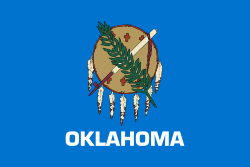 Flag of Oklahoma | |
| Currency | US$ (USD) |
|---|---|
| July 1 - June 30 | |
| Statistics | |
| GDP | $200.2 billion (nominal, Q1 2020) [1] |
| GDP rank | |
GDP growth | |
GDP per capita | $50,594 (2020 est) |
GDP by sector | Agriculture 2% Industry 34% Services 64% |
Population below poverty line | 15.2% (2011) [3] |
Labor force | |
Labor force by occupation | Agriculture 1% Industry 16% Services 83% |
| Unemployment | |
Average gross salary | $45,620 (Q2 2019) |
| External | |
| Exports | |
Export goods | Aircraft engines, motor vehicles, precious metals, pork meat |
Main export partners | |
| Imports | |
Import goods | Crude Oil, turbojets, computers |
Main import partners | |
| Public finances | |
| Revenues | $19.8 (FY2020) [9] (Taxation 49.3%, Federal Grants 38.9%, Other 11.8%) |
| Expenses | $19.8 billion (FY2014) [10] (Health Services 31.3 %, Education 26.1%, Social Services 12.4%, Gov't Admin 10.9%, Public Safety 4.6%, Debt Service 1.4%, Other 13.3%) |
| |
All values, unless otherwise stated, are in US dollars. | |
The economy of Oklahoma is the 30th largest in the United States. Oklahoma's gross state product (GSP) is approximately $197.2 billion as of December 2018.
